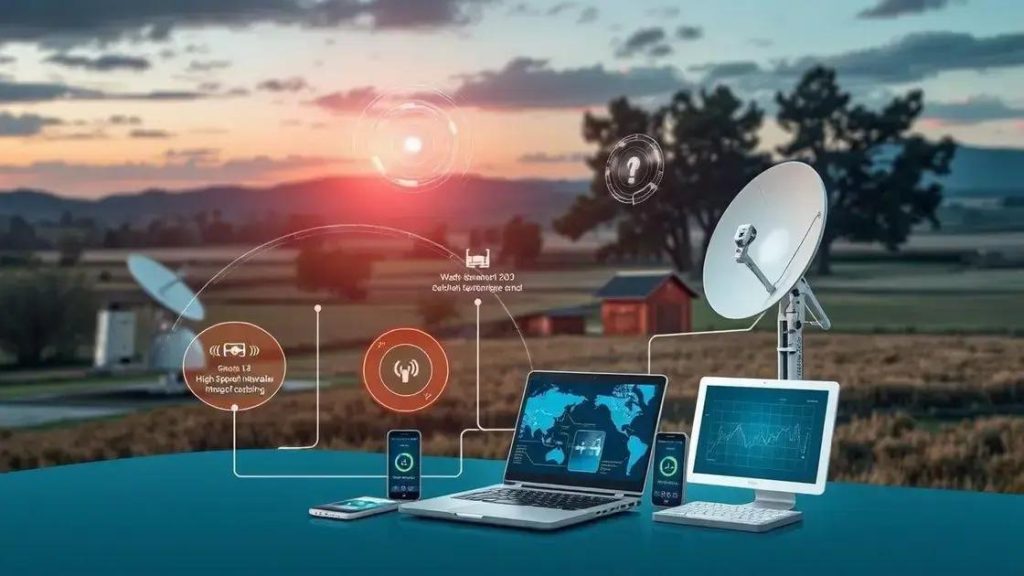Broadband expansion updates: what you need to know

Broadband expansion initiatives focus on increasing internet access through advanced technologies like 5G, fiber optics, and satellite services, while addressing challenges such as infrastructure, funding, and regulatory issues to enhance connectivity for all users.
Broadband expansion updates are essential as they shape how communities connect and thrive in a digital world. Have you ever wondered how these developments affect your daily life? In this article, we’ll delve into the latest updates and their significance.
Overview of current broadband expansion initiatives
As communities grow, the need for reliable internet has never been more critical. An overview of current broadband expansion initiatives reveals various efforts to bridge the digital divide in both urban and rural areas.
Government Programs
Governments at various levels are actively working to improve broadband access. These programs are designed to support both infrastructure development and affordability for users.
- Federal grants allocate funds to expand networks.
- State-level initiatives focus on specific underserved regions.
- Local governments partner with private companies to enhance services.
These initiatives aim to increase internet speeds and reduce costs, creating a more connected society.
Private Sector Involvement
Private companies play a critical role in the broadband expansion landscape. Many are investing heavily in technology and infrastructure to deliver high-speed internet.
Several major internet service providers (ISPs) are launching new projects to reach wider audiences. They focus on:
- Deploying fiber-optic networks for faster connections.
- Offering competitive pricing options to attract users.
- Creating partnerships with local entities to improve coverage.
The synergy between government initiatives and private investments is essential for significant improvements. When these two sectors collaborate, they can create effective solutions that meet community needs.
Furthermore, various non-profit organizations are also stepping in, advocating for low-income households and promoting digital literacy. Their work ensures that as broadband expands, everyone can access the benefits.
Overall, the combination of public and private efforts not only enhances broadband availability but also fosters economic growth and innovation. As these initiatives continue to evolve, the hope is for equitable access and affordable prices for all users.
Key players in broadband development
Understanding the key players in broadband development is crucial for grasping how internet access is expanding. These players include a mix of government entities, private companies, and community organizations that work together to improve connectivity.
Government Agencies
Government agencies play a significant role in establishing policies and funding for broadband expansion. They set rules and guidelines to ensure fair access to internet services.
- The Federal Communications Commission (FCC) regulates communication technologies.
- Local governments manage infrastructure projects.
- State governments often provide funding and incentives for broadband initiatives.
This collaboration drives many of the programs aimed at closing the digital divide.
Internet Service Providers (ISPs)
ISPs are at the forefront of broadband development. These companies build and maintain the networks that connect homes and businesses to the internet.
Many ISPs are investing in modern technologies to enhance their services. They focus on:
- Upgrading existing infrastructure to support higher speeds.
- Expanding coverage areas to underserved communities.
- Offering competitive plans to attract new customers.
The contributions of ISPs are vital, as they are often the ones who physically deliver internet service to users.
Community Organizations
Community organizations also play a crucial role in broadband expansion. They advocate for initiatives that address the needs of specific populations, ensuring that everyone has access to the internet.
These organizations help bridge gaps by:
- Promoting digital literacy and training programs.
- Working with local governments to identify areas in need.
- Creating partnerships with ISPs to enhance service availability.
Their engagement ensures that the voices of diverse communities are heard in broadband discussions, helping guide development efforts.
Overall, the collaboration among government agencies, ISPs, and community organizations creates a framework that facilitates effective broadband development. Each player contributes uniquely, which is essential for creating equitable access to the internet.
Impact of broadband on local economies

The impact of broadband on local economies is significant and multifaceted. Reliable internet access can transform communities, promote growth, and enhance quality of life.
Job Creation
Access to high-speed internet encourages businesses to flourish. When companies have reliable connectivity, they tend to:
- Expand their operations and reach new markets.
- Employ more local workers.
- Increase productivity through improved communication.
As a result, broadband can be a major driver of job creation in local areas.
Support for Small Businesses
Small businesses benefit immensely from broadband access. With the right tools and connectivity, these businesses can:
- Set up e-commerce platforms, reaching customers beyond their locality.
- Utilize online marketing strategies for growth.
- Access cloud services to streamline operations.
These advantages help local businesses innovate and thrive in a competitive marketplace.
Education and Workforce Development
Broadband also enhances educational opportunities. Students with internet access can:
- Engage in online learning and research projects.
- Access digital resources that help them succeed.
- Participate in virtual training programs.
This connectivity not only benefits students but also prepares a more skilled workforce for local employers.
Community Engagement
With broadband access, communities can connect and engage more effectively. Residents can stay informed about local events, participate in discussions, and access vital services online. This level of engagement fosters a sense of community and helps residents advocate for their needs.
Broadband’s positive effects extend beyond immediate economic benefits. It contributes to a vibrant community with enhanced education, increased business opportunities, and a greater sense of connectivity among residents.
Challenges to broadband expansion efforts
Exploring the challenges to broadband expansion efforts helps us understand the obstacles that must be overcome for better internet access. Various factors hinder the growth and implementation of broadband in many areas.
Infrastructure Limitations
One of the key challenges is the existing infrastructure. Many rural and underserved regions lack the basic facilities needed for broadband installation. Building this infrastructure can be expensive and time-consuming. Some specific issues include:
- Limited access to power sources for new technologies.
- Geographical barriers that complicate network deployment.
- High costs associated with laying cables in remote areas.
These infrastructure limitations present significant hurdles for expanding reliable internet service.
Funding and Financial Support
Another major challenge is securing adequate funding for broadband projects. Many communities struggle to attract the necessary investment. This lack of funds can stem from:
- Limited government budgets allocated for broadband development.
- The financial risk perceived by private investors.
- Competition for resources among various community needs.
Without sufficient financial backing, many projects remain stalled or underfunded.
Regulatory Hurdles
Regulatory issues can also slow broadband expansion. Complex rules and regulations may create bottlenecks in the deployment process. Some common regulatory challenges include:
- Permit delays hindering the installation timeline.
- Inconsistent policies across different regions.
- Restrictions on infrastructure development in certain areas.
These regulations can impede progress and complicate the efforts of service providers.
Digital Divide
The digital divide is a significant social challenge related to broadband expansion. Many low-income families cannot afford internet services, which limits their access to essential resources. Addressing this divide involves:
- Creating affordable options for internet access.
- Promoting digital literacy among underserved populations.
- Establishing community programs that support internet use and education.
Overcoming these challenges requires collaborative efforts from government, private companies, and community organizations. By addressing infrastructure, funding, regulatory issues, and the digital divide, we can pave the way for successful broadband expansion.
Future trends in broadband technology
Analyzing the future trends in broadband technology reveals exciting possibilities for connectivity. As technology evolves, so do the methods for delivering internet services to users.
5G Technology
One of the most significant advancements is the rollout of 5G networks. This new technology promises faster speeds and lower latency compared to current standards. It has the potential to revolutionize how users interact with the internet. Key features of 5G include:
- Higher capacity for more connected devices.
- Reduced lag for real-time applications such as gaming and virtual reality.
- Enhanced opportunities for smart city developments.
The impact of 5G will be profound, enabling innovations in various industries.
Fiber Optic Expansion
Another trend is the continued expansion of fiber optic networks. Fiber optic technology offers superior speed and reliability compared to traditional copper cables. As more communities invest in fiber, the benefits include:
- Faster download and upload speeds.
- Increased network reliability.
- Better support for bandwidth-intensive applications.
This expansion helps ensure that more areas receive high-quality internet service.
Satellite Internet Advances
Advancements in satellite internet are also noteworthy. Companies are launching more satellites to improve coverage in remote areas. These developments lead to:
- Wider access to high-speed internet for rural communities.
- Reduced latency compared to previous satellite technologies.
- More competition among providers, potentially lowering prices.
As technology improves, satellite internet can become a viable option for many users.
Wi-Fi 6 and Beyond
Wi-Fi technology is also evolving, with the introduction of Wi-Fi 6. This new standard offers enhanced performance in crowded environments. Some of its benefits include:
- Better multi-device support, allowing more users to connect simultaneously.
- Increased speed and efficiency for high-bandwidth applications.
- Improved battery life for connected devices.
As more households adopt smart devices, Wi-Fi 6 will play a crucial role in maintaining efficient connectivity.
Overall, the future of broadband technology looks promising. With innovations like 5G, fiber optics, satellite services, and Wi-Fi 6, connectivity will continue to improve, enhancing the digital experience for users everywhere.
FAQ – Frequently Asked Questions about Broadband Expansion
What is broadband expansion and why is it important?
Broadband expansion refers to efforts to improve and increase access to high-speed internet. It is important because it enhances connectivity, drives economic growth, and improves quality of life.
How will 5G technology impact broadband access?
5G technology will provide faster speeds and lower latency, enabling better connectivity and supporting more devices. This will enhance experiences in gaming, streaming, and smart city applications.
What are the challenges to broadband expansion?
Key challenges include infrastructure limitations, funding issues, regulatory hurdles, and the digital divide that affects low-income families.
What can individuals do to support broadband expansion efforts?
Individuals can advocate for better services in their communities, participate in local discussions about internet access, and support initiatives that promote digital literacy.





